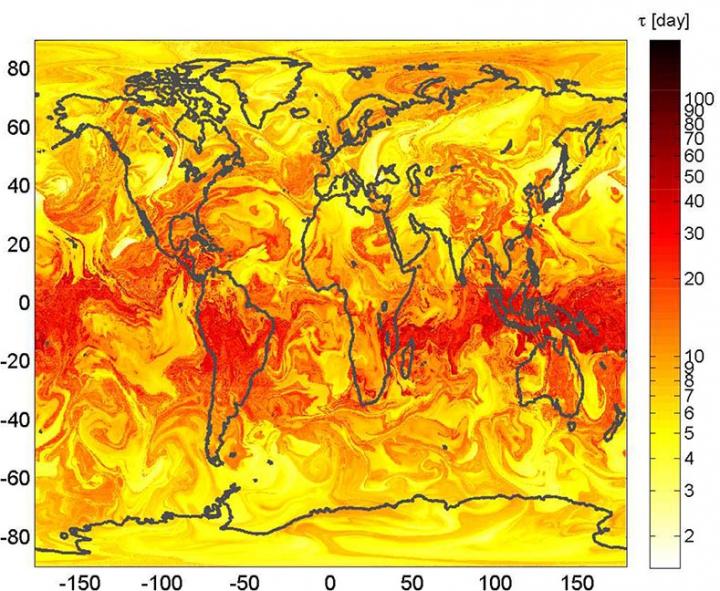Combining wind data with the fractal-like behavior that air particles take on in the atmosphere provides a way for determining how pollutants and volcanic ash will travel

Credit: Tímea Haszpra
WASHINGTON, D.C., July 16, 2019 — Floating air particles following disasters and other largescale geological events can have a lasting impact on life on Earth. Volcanic ash can be projected up to the stratosphere and halt air traffic by lingering in the atmosphere for months. Particles from industrial accidents have the potential to travel full hemispheres before falling to the ground. A new model drawing on chaos theory, and published in this week’s Chaos, from AIP Publishing, looks to help predict how particles move in such events with an eye toward potential applications for geoengineering to combat climate change.
Using available wind data, researcher Tímea Haszpra developed a model for following air particles as they travel around the globe. Using it, she has generated maps that can be used as atlases to predict how particles, such as volcanic ash or pollution, will be dispersed above the world.
“One of the most surprising parts of the research is the wide range of individual lifetimes,” she said. “Lifetimes ranged from about two to 150 days for typical volcanic ash particles. More than 10% of smaller particles survive in the atmosphere as much as one year, and more than 1% survive two years.”
Atmospheric particle motion exhibits fractal-like behavior, and when data is specially filtered, an object that governs chaotic particle motion and is called a chaotic saddle can be found. The paths of each simulated particle show properties that are transiently brought together by the changes in the flow of the atmosphere, akin to sitting on the saddle, before falling off the saddle and, consequently, falling to Earth.
In general, she found that particles coming from the area around the equator remain in the atmosphere for the longest time, and particles smaller than one micron could stay in the atmosphere for years before falling.
The average lifetime of a particle in the air is about one month, but they also found that particles in one area of a map could be in the air up to 10 times as long as particles nearby on the map. How these lifetimes were distributed around the globe varied depending on the season.
To illustrate the concepts in the paper, Haszpra has created an online game, called RePLaT-Chaos, that lets players learn the topic of atmospheric advection by creating and testing their own volcanic eruptions.
Haszpra believes her findings can inform future efforts that have been suggested to use sun-reflecting air particles to counteract climate change. She plans to expand on this work by incorporating historical meteorological data and climate models to better understand how the dispersion of particles might change when the climate changes.
###
The article, “Intricate features in the lifetime and deposition of atmospheric aerosol particles,” is authored by Tímea Haszpra. The article will appear in Chaos on July 16, 2019 (DOI: 10.1063/1.5110385). After that date, it can be accessed at http://aip.
ABOUT THE JOURNAL
Chaos is devoted to increasing the understanding of nonlinear phenomena in all disciplines and describing their manifestations in a manner comprehensible to researchers from a broad spectrum of disciplines. See http://chaos.
Media Contact
Larry Frum
[email protected]
Related Journal Article
http://dx.




